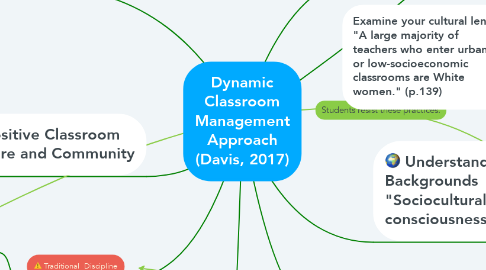Dynamic Classroom Management Approach (Davis, 2017)
by Ginger Lehmann


1. Effective Pedagogy
1.1. Asset-based model
1.1.1. Highlights students' strengths
1.1.1.1. What do students offer?
1.2. High expectations
1.2.1. Motivating
1.3. Culturally relevant
1.3.1. Highly engaging
1.3.1.1. Offers choice
1.4. Cohesive structure
1.5. Consistent
1.6. Effective de-escalation strategies
1.7. Decreases classroom management problems
2. Positive Classroom Culture and Community
2.1. Positive Relationships
2.2. Cooperative Learning
2.3. Mutual Respect
2.4. Building Change Agents
2.5. Academic goal-setting
3. Traditional Discipline
3.1. Control
3.1.1. Students act out
3.2. Obedience
3.3. Authority
3.3.1. Lack of student agency/voice
4. Restorative Justice: an alternative approach to discipline. (Davis, 2017, p.143-144)
4.1. Prioritizes relationships
4.2. "reparation and rehabilitation" (p.143)
4.3. "restoration of relationships and restitution to the community" (p.144)
5. Davis, J. (2017). From discipline to dynamic pedagogy: A re-conceptualization of classroom management. Berkeley Review of Education, 6(2), 129-153.
6. Flexibility and Adaptability
6.1. Avoids a uniform approach
6.1.1. Adapts styles and approaches
6.1.1.1. Flexibility in materials
6.2. Each class/student is different
6.2.1. Teacher must get to know individuals
6.3. All students should feel included
7. Understanding Diverse Backgrounds "Sociocultural consciousness" (p.137)
7.1. Learning styles
7.2. Socioeconomic context
7.3. Gender and sexuality
7.4. Cultural tastes
7.5. Communication style
7.5.1. Respect home culture
8. Traditional Classroom
8.1. Ethnocentric lens
8.2. Lack of intellectual engagement
8.2.1. Students act out
8.3. Deficit-based model
8.3.1. What do students lack?
